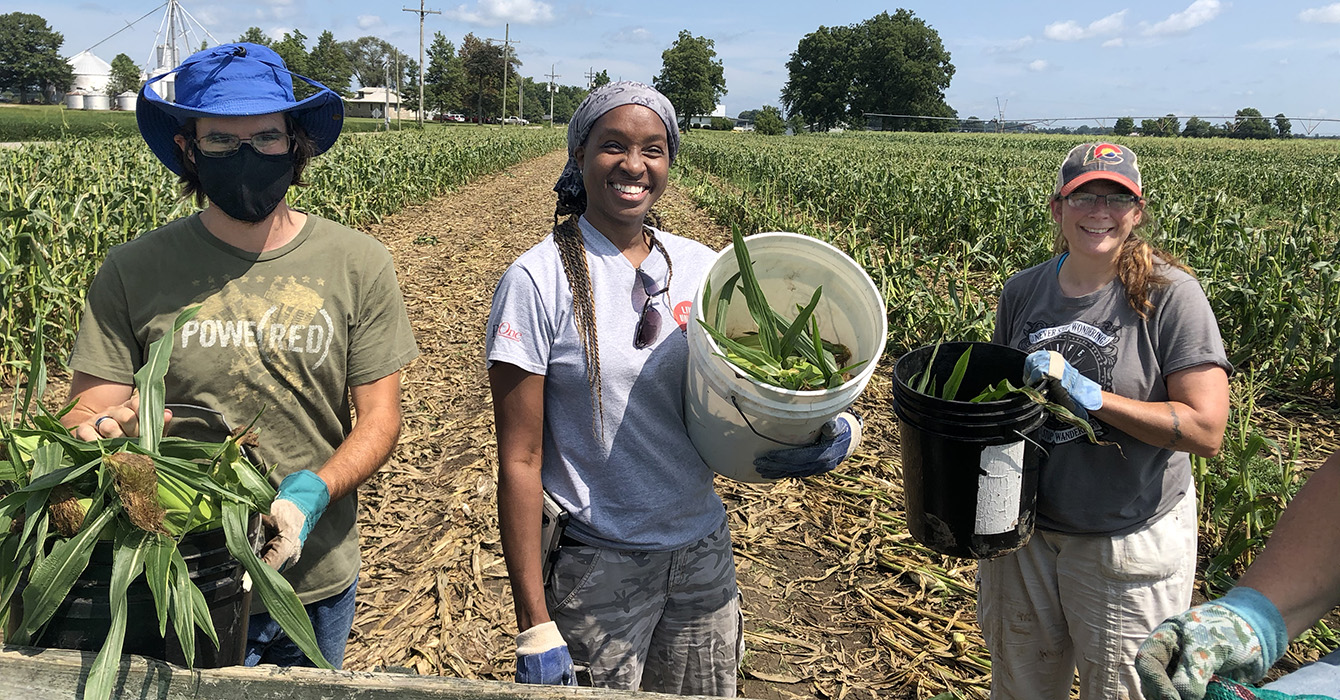Before I check email.
Before I dig into my to-do list.
Before I do anything else after arriving at work each morning at Church of the Pilgrims, I walk out to the church’s urban garden and watch, with awe, wonder and envy, the thousands of honeybees darting in and out of our beehives.
Standing as close as possible, I witness these creatures, backs laden with pollen, zoom in and out of the hives in their utilitarian quest to create the gorgeous, natural, golden substance known as honey. Then I go inside to work.
In the summer of 2009, Pilgrims, a Presbyterian (U.S.A.) congregation in Washington, D.C., created an urban garden to grow fresh produce for our weekly Sunday lunch for people who are homeless or hungry. Initially funded with a $500 grant from the National Capital Presbytery, the garden began with one raised bed.
In 2011, a church member suggested adding honeybee hives to increase the garden’s yield of produce. We were sold on the idea and, with the help of a local nonprofit called DC Honeybees, started with one beehive.
By summer 2012, our garden was flourishing, with four raised beds, an herb garden, four large compost bins, several bird feeders and three beehives filled with 40,000 fat, furry, buzzing and powerful little honeybees.
Our urban garden has connected Pilgrims with our local ecosystem in a way we never imagined. It gives witness that we trust in an Earth-honoring faith: our human healing and the healing of the planet are tied together.
And honeybees, it turns out, need healing.
Indeed, during the winter of 2006-07, many beekeepers in the U.S. reported losing from 30 to 90 percent of their honeybees, far beyond what might normally be expected. The deaths in these hives were sudden and occurred primarily among the worker bees -- those that travel in and out of the hive, foraging for nectar and pollen.
This phenomenon, called “colony collapse disorder,” and its potential impact are frightening. Honeybees pollinate more than 90 fruit and vegetable crops, in addition to trees and plants. We are so dependent on honeybees that Albert Einstein is reported to have said, “If honeybees become extinct, human society will follow in four years.”
Five years ago, scientists were predicting that honeybees would be extinct in the United States by 2035 if the disorder continues to spread at its current rate. Fortunately, they have since backed off that scenario, saying that honeybees will not disappear entirely -- but even so, the ongoing losses of hives will precipitate an agricultural crisis if not addressed.
But honeybees and their current plight are not the stuff of science alone. Theology speaks deeply to this subject, finding connection and meaning as well.
One of the primary narratives of the Hebrew Bible, of course, comes from Israel’s journey to the land of milk and honey. The journey is filled with danger and foreboding as God’s people are liberated from Pharaoh and seek freedom in the land of Canaan.
This image of “the land of milk and honey” is a vibrant symbol for the people of ancient Israel, one that holds together promise, challenge and new life. But for those making the journey, the image must have been hard to swallow. God was asking them to leave the fertile delta of Egypt and go into the mountainous, arid and almost-impossible-to-cultivate land of Canaan.
Likewise in the New Testament, we find a connection in the narrative of John the Baptist. The cousin, the one whose life was intricately intertwined with Jesus’, John is the one who walked the earth gently, purposefully, while eating locusts and wild honey.
With these images as our foundation, we installed our first beehive at Pilgrims on Palm Sunday 2011. Wrapping the installation in a homegrown liturgy, we invoked the ancient presence of honey, raised our consciousness around Pilgrims’ local ecosystem and invited everyone in attendance to take a yummy “shot” of milk and honey.
By that fall, we had expanded to our current three hives and wanted to integrate our garden more intentionally into the life of worship at Pilgrims. One of our first ideas came easily. In the ancient church, the first meal the newly baptized received was milk and honey. It was to remind them of the sweetness of life in Christ and the “promised land” they were now entering because of their baptism.
Drawing on this ancient tradition and the biblical stories, we began sharing milk and honey with our newly baptized, along with these words, added to our liturgy: With the living waters, may the justice and mercy of God flow from you like the sweetness of milk and honey.
Last spring we harvested 25 pounds of honey from one of our hives -- a little more than two gallons, enough to fill almost 70 four-ounce jars. As a result of one member’s creative suggestion, we now bottle the honey in small jars, which we give to visitors worshipping with us for the first time.
With the use of honey, this miraculous gift from our bees, we have expanded and enriched our liturgy at Pilgrims. Honey is now one of the “tools” in our liturgical toolkit, helping to create worship that is deeply linked to the ancient church.
When we gather honey during a beehive blessing, share it at a baptism or give it away as a symbol of God’s welcome, we are consuming and sharing the values of liberation and promise, lived in the stories of faith.
When we share honey with new folks, we are inviting them to come along on this journey of ancient stories and new beginnings. When we eat the honey, our cells, blood, bones, skin, tissue, neurons are nourished by the values of new life. We take in the incarnation, and we are called to live out these values on the planet that God so loves.
Our beehives have rooted and connected us to the biblical story and ancient church, far beyond our sanctuary walls. Our urban garden has become a liturgical space, with our beehives symbolizing that God’s promise, the Holy One’s movement of liberation, is alive in Pilgrims’ backyard.








